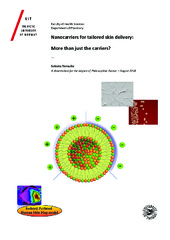Blar i forfatter "Ternullo, Selenia"
-
Curcumin-In-Deformable Liposomes-In-ChitosanHydrogel as a Novel Wound Dressing
Ternullo, Selenia; Schulte Werning, Laura; Holsæter, Ann Mari; Skalko-Basnet, Natasa (Journal article; Tidsskriftartikkel; Peer reviewed, 2019-12-20)A liposomes-in-hydrogel system as an advanced wound dressing for dermal delivery of curcumin was proposed for improved chronic wound therapy. Curcumin, a multitargeting poorly soluble active substance with known beneficial properties for improved wound healing, was incorporated in deformable liposomes to overcome its poor solubility. Chitosan hydrogel served as a vehicle providing superior wound ... -
Deformable liposomes for skin therapy with human epidermal growth factor: The effect of liposomal surface charge
Ternullo, Selenia; Basnet, Purusotam; Holsæter, Ann Mari; Flaten, Gøril Eide; de Weerd, Louis; Skalko-Basnet, Natasa (Journal article; Tidsskriftartikkel; Peer reviewed, 2018-10-07)The topical administration of exogenous human epidermal growth factor (hEGF) is a promising approach for improved chronic wound therapy. To develop therapeutically superior hEGF formulation, we prepared hEGF-containing neutral (NDLs), cationic (CDLs) and anionic (ADLs) deformable liposomes (DLs), respectively, since it is expected that the liposomal surface charge can affect both the liposomal ... -
Going skin deep: a direct comparison of penetration potential of lipid-based nanovesicles on the isolated perfused human skin flap model
Ternullo, Selenia; de Weerd, Louis; Holsæter, Ann Mari; Flaten, Gøril Eide; Skalko-Basnet, Natasa (Journal article; Tidsskriftartikkel, 2017-09-12)Phospholipid-based nanocarriers are attractive drug carriers for improved local skin therapy. In the present study, the recently developed isolated perfused human skin flap (IPHSF) model was used to directly compare the skin penetration enhancing potential of the three commonly used nanocarriers, namely conventional liposomes (CLs), deformable liposomes (DLs) and solid lipid nanoparticles (SLNs). ... -
The isolated perfused human skin flap model: A missing link in skin penetration studies?
Ternullo, Selenia; de Weerd, Louis; Flaten, Gøril Eide; Holsæter, Ann Mari; Skalko-Basnet, Natasa (Journal article; Tidsskriftartikkel; Peer reviewed, 2016-10-05)Development of effective (trans)dermal drug delivery systems requires reliable skinmodels to evaluate skin drug penetration. The isolated perfused human skin flap remainsmetabolically active tissue for up to 6 h during in vitro perfusion. We introduce the isolated perfused human skin flap as a close-to-in vivo skin penetration model. To validate the model's ability to evaluate skin drug penetration ... -
Mucus-PVPA (mucus Phospholipid Vesicle-based Permeation Assay): An artificial permeability tool for drug screening and formulation development
Falavigna, Margherita; Klitgaard, Mette; Brase, Christina; Ternullo, Selenia; Skalko-Basnet, Natasa; Flaten, Gøril Eide (Journal article; Tidsskriftartikkel; Peer reviewed, 2017-12-26)The mucus layer covering all mucosal surfaces in our body is the first barrier encountered by drugs before their potential absorption through epithelial tissues, and could thus affect the drugs’ permeability and their effectiveness. Therefore, it is of key importance to have in vitro permeability models that can mimic this specific environment. For this purpose, the novel mucus phospholipid vesicle-based ... -
Nanocarriers for tailored skin delivery: More than just the carriers?
Ternullo, Selenia (Doctoral thesis; Doktorgradsavhandling, 2018-11-23)Skin diseases are among the top 5 most leading diseases causing non-fatal health burden worldwide and strategies to assure more effective treatments are urgently needed. Dermal therapy is very attractive due to the direct administration of the drug at the diseased skin site thus minimizing systemic side effects associated with the oral and parenteral routes. However, the great variety within the ...


 English
English norsk
norsk




